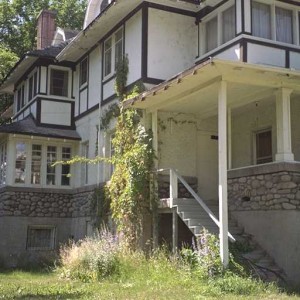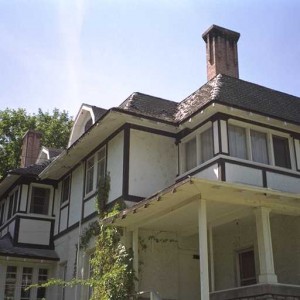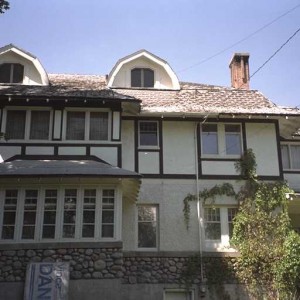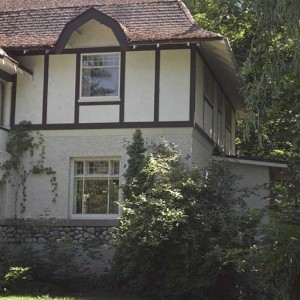W.A.C. Bennett House
Place Description
The historic place is the 2.5-storey W.A.C. Bennett House (Brookside Manor), built in 1914 in the Tudor Revival style at 1988 Bowes Street, in Kelowna's South Central neighbourhood. The historic place includes the larger property, now subdivided, that extends to Ethel Street to the west and to Mill Creek to the south.
Heritage Value
This house has heritage value for its powerful historical connections, seen in the associations with its builder and first occupant, F.R.E. DeHart, an important land developer and fruit industry leader; and with the next and long-time owner, W.A.C. Bennett, the most influential BC premier of the 20th century and the most important political figure in Kelowna history. The house also has value for its architectural quality, and for the reflection in the landscape of DeHart's skills as a horticulturalist.
Francis Richard Edwin DeHart was a key figure in the development of early Kelowna. Educated in horticulture at the Ontario Agricultural College, he came to Kelowna in 1903. He and four partners formed the Okanagan Fruit and Land Co., which purchased the 4,000-acre A.B. Knox Ranch and subdivided it into 5- and 10-acre lots. DeHart operated a nursery business and purchased fruit for export. He was famous for his prize-winning exhibits of Kelowna-grown fruit across the continent and as far away as Wembley, England. DeHart served on city council in 1907-08 and as mayor in 1909. He instigated the 'Cent a Pound or On the Ground' fruit growers' strike in 1933, which led to provincial marketing legislation and the formation of BC Tree Fruits Ltd.
In 1912 DeHart planned this large 21/2-storey Tudor Revival house, set within a 7-acre property. 'Brookside Manor' was completed in 1914. The marble floor in the entry hall displays his emblem, a heart inset with the letter 'D', and also a large square-and-compasses, symbol of his being a Freemason. The landscape has value for reflecting DeHart's achievements as a horticulturalist. He hybridized peonies, several dozen varieties of which lined the driveway. The property retains a variety of mature specimen trees.
In 1936, shortly after DeHart's death, the house and property were purchased by William Andrew Cecil Bennett. He had come to Kelowna in 1930 and purchased David Leckie's hardware store at 267-71 Bernard Avenue. Bennett, his wife May, and their three children settled into the house, where the couple lived out their lives.
Bennett expanded beyond the hardware business and became an investor and promoter of other local enterprises, including the Calona winery (although he was a teetotaler). He first tried provincial politics in 1937, seeking the Conservative nomination; he secured it in 1941 and won a seat in the provincial legislature. He remained the local MLA until his retirement from politics in 1973. In 1951 he joined the Social Credit Party, which he revived and led to victory in the 1952 provincial election. Bennett's historical significance lies in his having pushed forward large-scale development of the province, with an ambitious program of road-building, railway extension, and hydro-electric dams. He was especially proud of the Okanagan Lake Bridge, completed in 1958.
May Bennett was a very private person; this is seen in the house's being set away from public view. She told how she and her husband 'once made a pact that he would not get involved in running the home and she would not interfere in the family business or politics.' The exception was the Bennetts' annual garden parties in July, the 'Strawberry Teas', begun after he became premier. Invitations went to everyone on the voters' list. Bennett called this 'the largest non-alcoholic party in the world;' up to 15,000 people attended. The landscape has additional heritage value for this use. The garden parties ceased with W.A.C. Bennett's retirement from politics in 1973, but resumed in 1975 after his son Bill Bennett (who had grown up in this house) became premier.
After W.A.C. Bennett's death in 1979, May Bennett lived here until her death in 1989. The property, one of the last substantial estates near downtown, was subsequently developed with condominiums. The house and portions of the grounds have been conserved to serve as a common area for the use of homeowners in the Bennett Estate townhouses.
Character Defining Elements
- Tudor Revival style, seen in features such as the half-timbered second storey
- Gambrel (mansard) roof with bellcast eaves
- Projecting rafters beneath the eaves on the main roof and the small roof at the end of the ground-floor
- Rough stucco, and painted second-floor half-timbering
- Fieldstone dado capped with concrete block
- Foundation wall, constructed of local concrete block fabricated by Haug
- Corbelled brick chimneys
- Original windows are wood-frame, double-hung, with 1-over-1, 8-over-1 and 2-over-1 (bay windows) sash configuration
- Projecting window bays
- Colour scheme: off-white with dark brown trim
- Seven-acre property with large lawns, Mill Creek running through, pasture, fruit trees, many mature specimen deciduous trees, remnants of peonies









